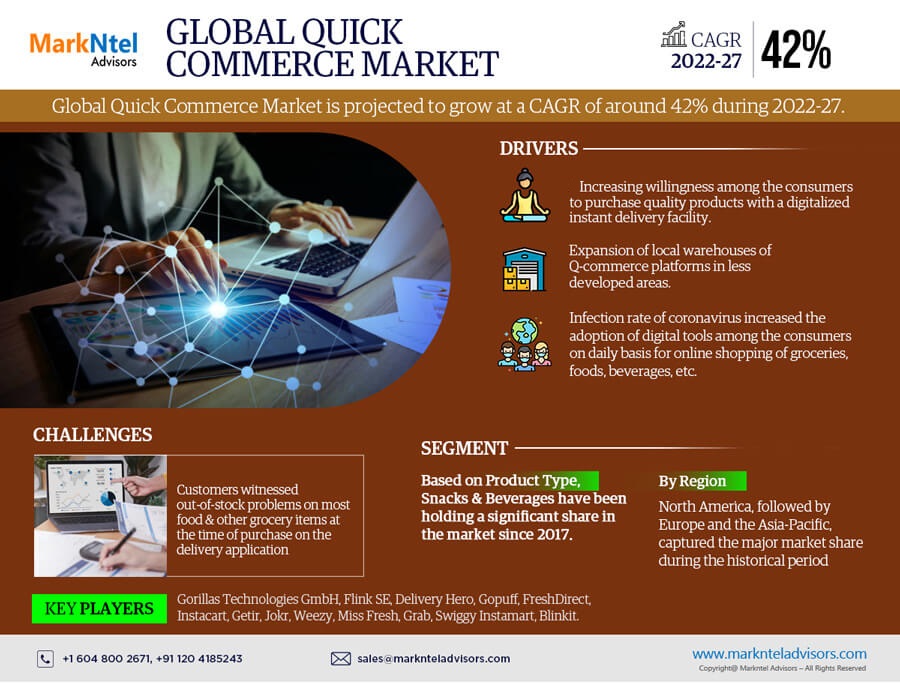
Global Quick Commerce (Q-Commerce) Market Research Report: Forecast (2022-2027)
By Product Type (Grocery, Snacks & Beverages, Bath & Beauty, Baby Essentials, Home Care), By Region (North America, South America, Europe, Middle East & Africa, Asia Pacific), By C...ompetitors (Gorillas Technologies GmbH, Flink SE, Delivery Hero, Gopuff, FreshDirect, Instacart, Getir, Jokr, Weezy, Miss Fresh, Grab, Swiggy Instamart, Blinkit) Read more
- FMCG
- Jun 2022
- Pages 211
- Report Format: PDF, Excel, PPT
Market Definition
Quick Commerce (Q-Commerce) is the next generation of e-commerce that brings small quantities of goods to customers instantly, whenever & wherever required by covering companies that provide speedy deliveries of daily items. The major factors contributing to the growth of the Quick Commerce market include changing lifestyles, growing urbanization, shifting consumer behavior, and rising consciousness towards the spread of viruses & other infections, thereby escalating the global market share of Quick Commerce in recent years.
Market Insights
The Global Quick Commerce Market is projected to grow at a CAGR of around 42% during the forecast period, i.e., 2022-27. The factors attributing to the growth of the Quick Commerce market is the increasing willingness among the consumers worldwide to purchase quality products such as groceries, drinks, snacks, etc., at their doorstep with a digitalized instant delivery facility. Along with this, the rising disposable income of the population is further facilitating the Q-commerce services in the regions such as North America, Asia-Pacific, Europe, etc., as the customers have become capable of paying extra delivery charges on daily-based-useful products.
| Report Coverage | Details |
|---|---|
| Study Period | Historical Data: 2017-20 |
| Base Year: 2021 | |
| Forecast Period: 2022-27 | |
| CAGR(2022-27) | 42% |
| Regions Covered | North America: The US, Canada, Mexico |
| South America: Brazil, Argentina, Rest of South America | |
| Europe: Germany, The UK, France, Spain, Russia, Rest of Europe | |
| Asia-Pacific: China, Japan, India, South Korea, Australia, Rest of Asia Pacific | |
| Middle East & Africa: Saudi Arabia, The UAE, Egypt, Turkey, Rest of The Middle East & Africa | |
| Key Companies Profiled | Gorillas Technologies GmbH, Flink SE, Delivery Hero, Gopuff, FreshDirect, Instacart, Getir, Jokr, Weezy, Miss Fresh, Grab, Swiggy Instamart, Blinkit, Others. |
| Unit Denominations | USD Million/Billion |
In addition, the expansion of local warehouses of Q-commerce platforms in less developed areas of the countries like India, China, the US, etc., to increase the accessibility of home essentials has also been positively impacting the Global Quick Commerce (Q-commerce) Market. For instance:
- In 2022, Blinkit (Grofers) announced to open 200 dark stores in India to facilitate grocery delivery services in ten minutes, owing to the spike in online orders.
In 2020, the Q-commerce services experienced a considerable demand due to the flare-up of the COVID-19 pandemic. Additionally, lockdown imposed by the governments of several countries to curb the infection rate of coronavirus increased the adoption of digital tools among the consumers on daily basis for online shopping of groceries, foods, beverages, etc. This, in turn, positively impacted the market of Q-commerce worldwide. Furthermore, the growing prevalence of digitalization of shopping platforms, as a whole, across the globe is projected to drive the Q-commerce market in the forecast years.
Key Trend in the Market
- Integration of Artificial Intelligence & Machine Learning with the Quick Commerce Platform
The incorporation of Artificial Intelligence (AI) in Q-commerce is increasing the marketing standards for several companies. Moreover, it has helped in creating a more personalized experience by performing the analysis of customer data sets & by identifying different patterns of consumer behavior. Furthermore, the ongoing technological advancements in AI enable companies to track demand & adjust their inventory in real-time, which would enhance the growth of the market. Thus, the implementation of AI in Quick Commerce led companies to do more accurate target marketing & advertising, enhance customer retention, as well as improve sales process efficiencies.
Impact of Covid-19 on the Global Quick Commerce Market
The outbreak of the COVID-19 virus led to the emergence of Quick Commerce in various countries such as the US, Canada, India, China, Germany, etc., owing to the movement restriction measures to safeguard public health as well as growing customer need to avoid physical stores. Quick Commerce includes a new business model which provides the fastest delivery of goods & services within 10-30 minutes after ordering. Further, the COVID-19 crisis escalated the expansion of Q-commerce towards new firms, customers as well as different types of groceries products.
Additionally, before the pandemic, consumers were largely dependent upon conventional retail stores, hypermarkets, supermarkets, etc. However, COVID-19 turned consumers to adopt online platforms like Quick Commerce for buying food items & other day-to-day essentials. Hence, this phenomenon also pushed users of different age groups to take advantage of online shopping while fulfilling their everyday requirements of food & beverages, snacks, etc., within a minimum period. However, the segment also experienced a tremendous setback due to factors, concerning disrupted supply chain networks & cross-border trade restrictions, which resulted in the delay in consignments of food, beverages, and other grocery products by the manufacturers.
In addition, as manufacturing units were closed due to government restrictions, created non-availability of products in the dark stores. In contrast, post-COVID-19, the restrictions were gradually eased & the availability of the products in the dark stores was increased as consumers started opting for Quick Commerce platforms for convenient home delivery for home essential items.

Market Segmentation
Based on the Product Type:
- Grocery
- Snacks & Beverages
- Bath & Beauty
- Baby Essentials
- Home Care
- Others (Pets, Office Supplies, Healthcare, Alcohol, etc.)
Of them all, Snacks & Beverages have held a significant share in the Global Quick Commerce (Q-commerce) market since 2017, in line with the growing consumption of carbonated drinks, juices, baked biscuits, fried potato chips, etc., among the millennials in the countries such as the US, India, Canada, etc. As per the Institute of Food Technologists, United States, in 2021, adults in the US consume 2.7 snacks per day, along with an increased intake of five or more snacks on daily basis. In addition, the availability of a wide range of snacks & beverages on Q-commerce platforms would also attract the customers, hence would propel the demand for Q-commerce services.
Regional Landscape
Geographically, the Global Quick Commerce Market expands across:
- North America
- South America
- Europe
- Middle East & Africa
- Asia-Pacific
Of all the regions, North America followed by Europe & the Asia-Pacific captured the major market share in the Global Quick Commerce market. The major factor attributing to the growth across the countries of North America, Europe, and Asia-Pacific is due to the busy lifestyles, smaller households, urbanization as well as aging populations, which necessitated the need for speed & convenient delivery of day-to-day essentials. In addition, the advent of the pandemic has accentuated these needs, predominantly in terms of commerce delivery. Furthermore, the adoption of Quick Commerce delivery is more likely to be preferred by consumers as social distancing & the prevalence of working from home had led consumers to be less preferably visit stores. As per OECD statistics, in 2020, 21% of US consumers ordered groceries online from a nearby store as a direct result of the COVID-19.
Moreover, owing to the presence of leading market players, viz., GoPuff, JOKR, Instacart Buyk, etc., in North America has propelled the market of Quick Commerce in the region. Furthermore, these companies have raised funding to open new dark to enhance their delivery reach in the region. In 2021, Buyk raised its funding to about USD46 million to expand its business & enhance sales. Consequently, the increased funding, helped companies set up micro warehouses that are closer to the source of delivery & keep the stock at these dark stores. These developments would further escalate the Quick Commerce market in the region in the upcoming years. For instance:
- From July 2020 to July 2021, Instacart increased its delivery reach from 30,000 stores to nearly 55,000 stores in North America & captured over 85% of US households.
Recent Developments by the Leading Companies
- In 2022, Getir, an instant delivery start-up announced that it has raised Series E funding to about USD768 million. The investment enables the company to expand its ultra-fast delivery sector as well as to develop proposition & technology so as to attract more & more customers.
- In 2022, BigBasket planned to set up 300 dark stores across India with the goal to serve 300,000 orders per day.
- In 2021, Swiggy announced an investment of around USD700 million in express grocery delivery service, Instamart, so as to intensify the competition in the fast-moving Quick Commerce space in India.
Market Dynamics:
Key Driver: Burgeoning Investments by the Quick Commerce Companies to Flourish the Market Growth
The demand for Q-commerce services in several countries such as the US, Italy, China, etc., has been notable during the historical period, owing to the growing number of digital applications for purchasing groceries, beverages, pet care products, etc., coupled with the burgeoning investments by the Quick Commerce companies. In addition, the rising awareness among the consumers about the instant home essentials delivery platforms has been encouraging the Quick Commerce providers to invest massively to improve their services such as fast forward deliveries, diversified product portfolio, etc.
Therefore, the rising spike in online grocery orders would likely increase the investments by the Quick Commerce companies in the forthcoming years, which, in turn, would positively contribute to the growth of the Global Quick Commerce (Q-commerce) Market.
Possible Restraint: Lack of Real-time Visibility on Retailer's In-store Inventory to Hinder the Market Growth
As the Quick Commerce retail space is booming drastically, it also found a gap between third-party retailers & vertically integrated instant-need companies. These instant delivery companies do not have full- & real-time visibility into their retailer's in-store inventory. Consequently, the customers witnessed out-of-stock problems on most of the food & other grocery items at the time of purchase on the delivery application, hence acting as a challenge for the growth of the Quick Commerce market across the globe.
Growth Opportunity: Adoption of Hybrid Approach in Quick Commerce Platform
The quick-commerce gained momentum in recent years due to its instant delivery that delivers orders from local, third-party retailers, as well as vertically integrated instant-need companies. With the growing fast-delivery need of customers, there is a need to adopt a hybrid approach to a Quick Commerce platform. Furthermore, the integration of a hybrid platform in Quick Commerce enhances third-party delivery capabilities as well as enables vertically integrated instant-need companies to operate through dark stores.
Hence, this approach helped companies to keep a proper watchdog on the in-store inventory & minimize the customer problem of out-of-stock while ordering essentials on delivery apps, inclining the growth of the Quick Commerce market in the foreseen years.
Key Questions Answered in the Market Research Report:
- What are the overall statistics or estimates (Overview, Size- By Value, Forecast Numbers, Segmentation, Shares) of the Global Quick Commerce Market?
- What are the region-wise industry size, growth drivers, and challenges?
- What are the key innovations, opportunities, current & future trends, and regulations in the Global Quick Commerce Market?
- Who are the key competitors, their key strengths & weaknesses, and how do they perform in the Global Quick Commerce Market based on the competitive landscape?
- What are the key results derived from surveys conducted during the Global Quick Commerce Market study?
Frequently Asked Questions
- Introduction
- Product Definition
- Research Process
- Market Segmentation
- Assumptions
- Executive Summary
- Impact of COVID-19 on Global Quick Commerce (Q-Commerce) Market
- Global Consumer Behaviour Analysis
- Buyers Profile
- Age
- Sex
- Country of Domicile
- Income Group
- Profession
- Willingness to opt Q Commerce
- Reasons to Opt Q-Commerce
- Region wise Penetration
- Most Preferred Things to Buy
- Things Customers Willing to Buy via Q Commerce in Next Couple of Years
- Expectations from the Q-Commerce Companies
- Buyers Profile
- Global Quick Commerce (Q-Commerce) Market Trends & Insights
- Global Quick Commerce (Q-Commerce) Market Dynamics
- Drivers
- Challenges
- Global Quick Commerce (Q-Commerce) Market Regulations & Policies
- Global Quick Commerce (Q-Commerce) Market Hotspots & Opportunities
- Global Quick Commerce (Q-Commerce) Market Start-up Ecosystem
- Entrepreneurial Activity
- Year on Year Funding Received
- Funding Received by Top Companies
- Key Investors Active in the Market
- Series Wise Funding Received
- Seed Funding
- Angel Investing
- Venture Capitalists (VC) Funding
- Others
- Global Quick Commerce (Q-Commerce) Market, 2022
- Total Addressable Market (TAM)
- Service Obtainable Market (SAM)
- Serviceable Available Market (SOM)
- Global Quick Commerce (Q-Commerce) Market Outlook, 2017-2027
- Market Size & Analysis
- By Revenues (USD Million)
- Market Share & Analysis
- By Product Type
- Grocery
- Snacks & Beverages
- Bath & Beauty
- Baby Essentials
- Home Care
- Others (Pets, Office Supplies, Healthcare, Alcohol, etc.)
- By Region
- North America
- South America
- Europe
- The Middle East & Africa
- Asia Pacific
- By Company
- Competition Characteristics
- Operating Model & Capabilities
- Market Share of Leading Companies
- By Product Type
- Market Size & Analysis
- North America Quick Commerce (Q-Commerce) Market Outlook, 2017-2027
- Market Size & Analysis
- By Revenues (USD Million)
- Market Share & Analysis
- By Product Type
- By Country
- The US
- Canada
- Mexico
- The US Quick Commerce (Q-Commerce) Market Outlook, 2017-2027
- Market Size & Analysis
- By Revenues (USD Million)
- Market Share & Analysis
- By Product Type
- Market Size & Analysis
- Canada Quick Commerce (Q-Commerce) Market Outlook, 2017-2027
- Market Size & Analysis
- By Revenues (USD Million)
- Market Share & Analysis
- By Product Type
- Market Size & Analysis
- Mexico Quick Commerce (Q-Commerce) Market Outlook, 2017-2027
- Market Size & Analysis
- By Revenues (USD Million)
- Market Share & Analysis
- By Product Type
- Market Size & Analysis
- Market Size & Analysis
- South America Quick Commerce (Q-Commerce) Market Outlook, 2017-2027
- Market Size & Analysis
- By Revenues (USD Million)
- Market Share & Analysis
- By Product Type
- By Country
- Brazil
- Argentina
- Rest of South America
- Brazil Quick Commerce (Q-Commerce) Market Outlook, 2017-2027
- Market Size & Analysis
- By Revenues (USD Million)
- Market Share & Analysis
- By Product Type
- Market Size & Analysis
- Argentina Quick Commerce (Q-Commerce) Market Outlook, 2017-2027
- Market Size & Analysis
- By Revenues (USD Million)
- Market Share & Analysis
- By Product Type
- Market Size & Analysis
- Market Size & Analysis
- Europe Quick Commerce (Q-Commerce) Market Outlook, 2017-2027
- Market Size & Analysis
- By Revenues (USD Million)
- Market Share & Analysis
- By Product Type
- By Country
- Germany
- The UK
- France
- Russia
- Spain
- Rest of Europe
- Germany Quick Commerce (Q-Commerce) Market Outlook, 2017-2027
- Market Size & Analysis
- By Revenues (USD Million)
- Market Share & Analysis
- By Product Type
- Market Size & Analysis
- The UK Quick Commerce (Q-Commerce) Market Outlook, 2017-2027
- Market Size & Analysis
- By Revenues (USD Million)
- Market Share & Analysis
- By Product Type
- Market Size & Analysis
- France Quick Commerce (Q-Commerce) Market Outlook, 2017-2027
- Market Size & Analysis
- By Revenues (USD Million)
- Market Share & Analysis
- By Product Type
- Market Size & Analysis
- Russia Quick Commerce (Q-Commerce) Market Outlook, 2017-2027
- Market Size & Analysis
- By Revenues (USD Million)
- Market Share & Analysis
- By Product Type
- Market Size & Analysis
- Spain Quick Commerce (Q-Commerce) Market Outlook, 2017-2027
- Market Size & Analysis
- By Revenues (USD Million)
- Market Share & Analysis
- By Product Type
- Market Size & Analysis
- Market Size & Analysis
- The Middle East & Africa Quick Commerce (Q-Commerce) Market Outlook, 2017-2027
- Market Size & Analysis
- By Revenues (USD Million)
- Market Share & Analysis
- By Product Type
- By Country
- Saudi Arabia
- The UAE
- Egypt
- Turkey
- Rest of The Middle East & Africa
- Saudi Arabia Quick Commerce (Q-Commerce) Market Outlook, 2017-2027
- Market Size & Analysis
- By Revenues (USD Million)
- Market Share & Analysis
- By Product Type
- Market Size & Analysis
- The UAE Quick Commerce (Q-Commerce) Market Outlook, 2017-2027
- Market Size & Analysis
- By Revenues (USD Million)
- Market Share & Analysis
- By Product Type
- Market Size & Analysis
- Egypt Quick Commerce (Q-Commerce) Market Outlook, 2017-2027
- Market Size & Analysis
- By Revenues (USD Million)
- Market Share & Analysis
- By Product Type
- Market Size & Analysis
- Turkey Quick Commerce (Q-Commerce) Market Outlook, 2017-2027
- Market Size & Analysis
- By Revenues (USD Million)
- Market Share & Analysis
- By Product Type
- Market Size & Analysis
- Market Size & Analysis
- Asia Pacific Quick Commerce (Q-Commerce) Market Outlook, 2017-2027
- Market Size & Analysis
- By Revenues (USD Million)
- Market Share & Analysis
- By Product Type
- By Country
- China
- Japan
- India
- South Korea
- Australia
- Rest of Asia Pacific
- China Quick Commerce (Q-Commerce) Market Outlook, 2017-2027
- Market Size & Analysis
- By Revenues (USD Million)
- Market Share & Analysis
- By Product Type
- Market Size & Analysis
- Japan Quick Commerce (Q-Commerce) Market Outlook, 2017-2027
- Market Size & Analysis
- By Revenues (USD Million)
- Market Share & Analysis
- By Product Type
- Market Size & Analysis
- India Quick Commerce (Q-Commerce) Market Outlook, 2017-2027
- Market Size & Analysis
- By Revenues (USD Million)
- Market Share & Analysis
- By Product Type
- Market Size & Analysis
- South Korea Quick Commerce (Q-Commerce) Market Outlook, 2017-2027
- Market Size & Analysis
- By Revenues (USD Million)
- Market Share & Analysis
- By Product Type
- Market Size & Analysis
- Australia Quick Commerce (Q-Commerce) Market Outlook, 2017-2027
- Market Size & Analysis
- By Revenues (USD Million)
- Market Share & Analysis
- By Power Capacity
- By End Users
- Market Size & Analysis
- Market Size & Analysis
- Global Quick Commerce (Q-Commerce) Market Key Strategic Imperatives for Growth & Success
- Competition Outlook
- Competition Matrix
- Brand Specialization
- Target Markets
- Target End Users
- Research & Development
- Strategic Alliances
- Strategic Initiatives
- Company Profiles
- Gorillas Technologies GmbH
- Flink SE
- Delivery Hero
- Gopuff
- FreshDirect
- Instacart
- Getir
- Jokr
- Weezy
- Miss Fresh
- Grab
- Swiggy Instamart
- Blinkit
- Others
- Competition Matrix
- Disclaimer
MarkNtel Advisors follows a robust and iterative research methodology designed to ensure maximum accuracy and minimize deviation in market estimates and forecasts. Our approach combines both bottom-up and top-down techniques to effectively segment and quantify various aspects of the market. A consistent feature across all our research reports is data triangulation, which examines the market from three distinct perspectives to validate findings. Key components of our research process include:
1. Scope & Research Design At the outset, MarkNtel Advisors define the research objectives and formulate pertinent questions. This phase involves determining the type of research—qualitative or quantitative—and designing a methodology that outlines data collection methods, target demographics, and analytical tools. They also establish timelines and budgets to ensure the research aligns with client goals.
2. Sample Selection and Data Collection In this stage, the firm identifies the target audience and determines the appropriate sample size to ensure representativeness. They employ various sampling methods, such as random or stratified sampling, based on the research objectives. Data collection is carried out using tools like surveys, interviews, and observations, ensuring the gathered data is reliable and relevant.
3. Data Analysis and Validation Once data is collected, MarkNtel Advisors undertake a rigorous analysis process. This includes cleaning the data to remove inconsistencies, employing statistical software for quantitative analysis, and thematic analysis for qualitative data. Validation steps are taken to ensure the accuracy and reliability of the findings, minimizing biases and errors.

4. Data Forecast and FinalizationThe final phase involves forecasting future market trends based on the analyzed data. MarkNtel Advisors utilize predictive modeling and time series analysis to anticipate market behaviors. The insights are then compiled into comprehensive reports, featuring visual aids like charts and graphs, and include strategic recommendations to inform client decision-making









